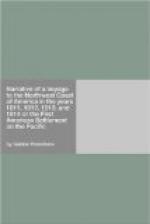Fort William has really the appearance of a fort, with its palisade fifteen feet high, and that of a pretty village, from the number of edifices it encloses. In the middle of a spacious square rises a large building elegantly constructed, though of wood, with a long piazza or portico, raised about five feet from the ground, and surmounted by a balcony, extending along the whole front. In the centre is a saloon or hall, sixty feet in length by thirty in width, decorated with several pieces of painting, and some portraits of the leading partners. It is in this hall that the agents, partners, clerks, interpreters, and guides, take their meals together, at different tables. At each extremity of the apartment are two rooms; two of these are destined for the two principal agents; the other two to the steward and his department. The kitchen and servants’ rooms are in the basement. On either side of this edifice, is another of the same extent, but of less elevation; they are each divided by a corridor running through its length, and contain each, a dozen pretty bed-rooms. One is destined for the wintering partners, the other for the clerks. On the east of the square is another building similar to the last two, and intended for the same use, and a warehouse where the furs are inspected and repacked for shipment. In the rear of these, are the lodging-house of the guides, another fur-warehouse, and finally, a powder magazine. The last is of stone, and has a roof covered with tin. At the angle is a sort of bastion, or look-out place, commanding a view of the lake. On the west side is seen a range of buildings, some of which serve for stores, and others for workshops; there is one for the equipment of the men, another for the fitting out of the canoes, one for the retail of goods, another where they sell liquors, bread, pork, butter, &c., and where a treat is given to the travellers who arrive. This consists in a white loaf, half a pound of butter, and a gill of rum. The voyageurs give this tavern the name of Cantino salope. Behind all this is another range, where we find the counting-house, a fine square building, and well-lighted; another storehouse of stone, tin-roofed; and a jail, not less necessary than the rest. The voyageurs give it the name of pot au beurre—the butter-tub. Beyond these we discover the shops of the carpenter, the cooper, the tinsmith, the blacksmith, &c.; and spacious yards and sheds for the shelter, reparation, and construction of canoes. Near the gate of the fort, which is on the south, are the quarters of the physician, and those of the chief clerk. Over the gate is a guard-house.




